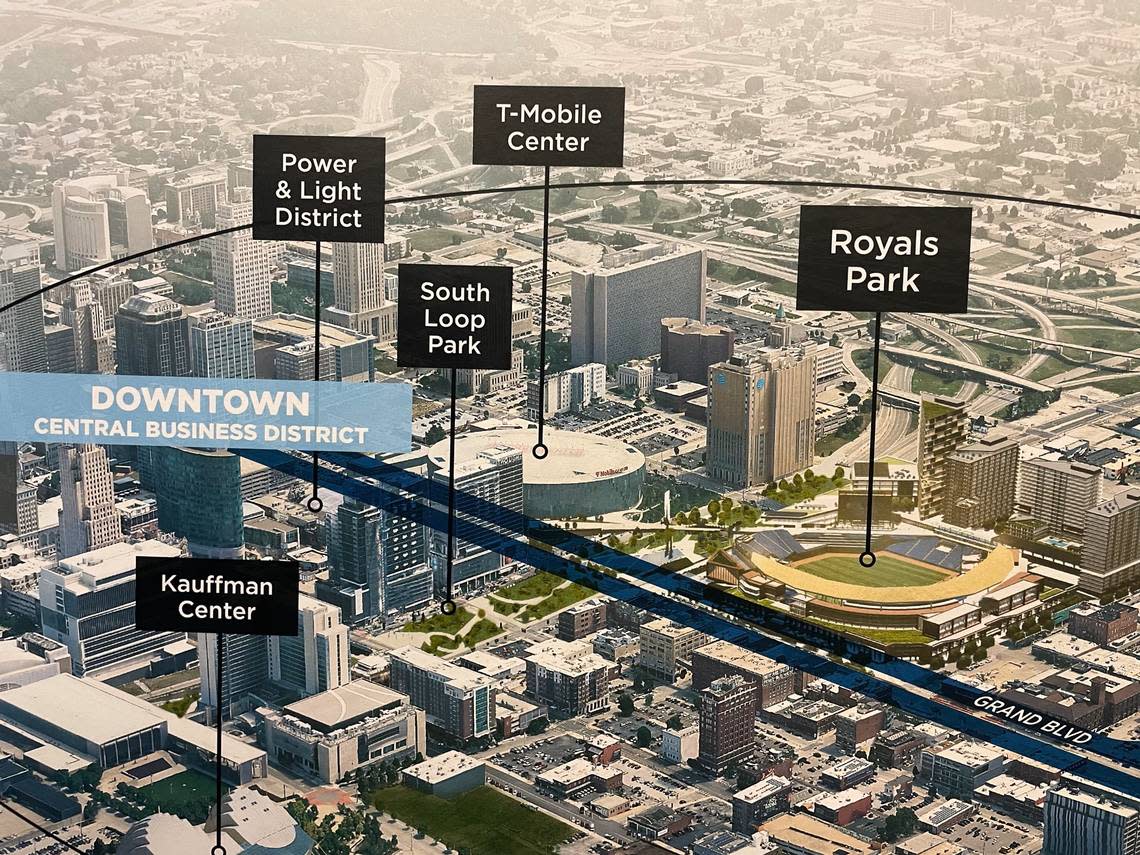Despite compelling renderings, Royals project at crossroads in more ways than one

When the Chiefs won their third Super Bowl in five seasons on Sunday in Las Vegas, it stamped an exclamation point on an astounding time in Kansas City sports history.
A week earlier, FIFA announced that GEHA Field at Arrowhead Stadium would play host to six 2026 World Cup matches — including a quarterfinal. Six days prior, the Royals signed budding star Bobby Witt Jr. to an 11-year contract extension worth $288.7 million guaranteed. And next month, the Kansas City Current will make its debut at CPKC Stadium, the first purpose-built venue for a women’s professional team.
No wonder the Royals sought to ride that momentum this week by finally making public the intended site of their campaign to move out of the Truman Sports Complex to downtown Kansas City — a move contingent on voters in an April election approving a 40-year extension of the current 3/8th-cent sales tax equally connected to the Chiefs’ desires to renovate Arrowhead.
Seeking to seize on Chiefs fever on the eve of the Super Bowl parade enabled by the pivotal assistance of “Royals investor Patrick Mahomes,” as Royals owner John Sherman called him, the Royals released renderings of their vision for a stadium and attached development in the Crossroads Arts District.
“This is going to be awesome!!! Can’t wait,” Mahomes posted on social media, accented with a flexing bicep emoji.
As he introduced the project at Kauffman Stadium, Sherman set up the official reveal — previously reported by The Star’s Sam McDowell — by speaking of the franchise itself being at a crossroads after 50-plus years at Kauffman.
Trouble is, even entwined with the Chiefs, the Royals are going to have to contend with some gridlock at this crossroads to the election.
Because while the gorgeous depictions capture the imagination and suggest considerable connective and synergistic appeal, too many essential questions remain unanswered to be able to endorse a yes vote at this point.
Royals downtown stadium announcement didn’t happen overnight. Here’s how we got here
As I try to negotiate a blurry line between healthy skepticism and reflexive cynicism on this, I find myself compelled by the possibilities but repelled by the risks and blanks yet to be filled in.
Such as several aspects of who would pay for what, including the extended capping of Interstate 670 as drawn up. Or what a completed community benefits agreement ultimately entails. And how much this will ultimately cost the public beyond the private investment the Royals say will be more than $1 billion.
Beyond those more general concerns, one difficult-to-predict issue looms particularly large over the specific 17.3-acre footprint that would feature the former Star printing plant at the epicenter and be framed by Grand Boulevard to Locust Street and Truman Road to 17th Street.
Would the proposed development — an approximately 34,000-seat stadium, separate team offices and conference center, a hotel, a residential and entertainment venue and South Loop Park Extension & Bridge over 670 — truly serve to fuse together the Power & Light District and Crossroads as stated?
And help engage the Negro Leagues Baseball Museum and 18th & Vine as conceptualized?
Would it more likely catalyze all of downtown or erode the unique vibe of the Crossroads?
To a more tangible point, the Royals evidently have not yet acquired any of the property they need to break ground in 2025 as hoped (toward a 2028 opening) if the April initiative does pass.
Brooks Sherman, the Royals’ president of business operations, estimated that the overall land is held by about 20 property owners. The Star’s Mike Hendricks reported that city land records show 18 real estate parcels belonging to 13 separate owners make up the two blocks immediately to the west of the former Star building between McGee Street and Grand Boulevard and from 17th Street to Truman Road.
“Those are negotiations that we’re in now, that are underway now,” said Sherman, no relation to John Sherman.
Will Missouri help Royals pay for new KC stadium? It could depend on upcoming tax vote
Meanwhile, there will be six weeks of key negotiations with another constituency: the voters who will decide.
The trick for the Royals, and the Chiefs, for that matter, is that a process that included declaring two other sites as finalists in August has left little time to promote these specifics.
And the ambiguity along the way certainly left some entrenched against any such project.
Certainly, many don’t want to see the Royals leave The K, plenty wonder why their money should continue going towards these endeavors at all and others now have legitimate anxiety about the lurking downside of going to the Crossroads.
For what it’s worth from this corner, I still think it’s important to keep an open mind as we wait to see how many of these questions the Royals will clarify in the run-up to election day.
There is a lot to sort through, to be sure, but that includes incredible upside if this is done right.
But it’s not just a generational crossroads for the Royals; it’s one for Kansas City itself that merits every possible answer it can get as it considers a potentially transformative commitment in more ways than one.


